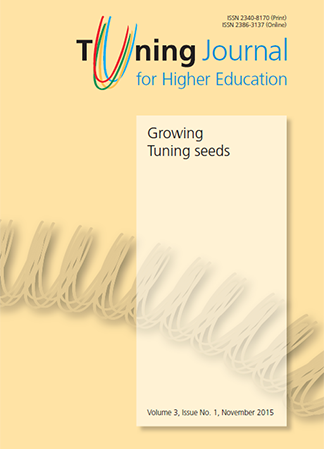Implementation of Competence-Based Learning Approach: stories of practices and the Tuning contribution to academic innovation
Abstract
The rationale of the present paper is to investigate and stimulate a reflection on the Tuning contribution to academic innovation through the collection of case studies among some Tuning projects, focussing on methods and tools to implement successful and innovative approaches to learning, teaching, and assessment appropriate for competence-based approach (CBA). In order to deepen these concepts, a conceptual framework on competence-based approach and student-centred learning will be presented, particularly focussing teacher conceptions of teaching as well as pedagogical content knowledge and their influence on teaching practices. The Tuning contribution in supporting academic innovation will then be deepened, through a macro-level overview of the methodology, and a synoptic table of cross-cutting themes identified across the Tuning projects will be the starting point of the empirical part of this study. Moreover, the multiple case studies conducted through semi-structured interviews with teachers from Higher Education Institutes involved in previous completed Tuning projects will be presented. Research design, sampling and data analysis will be described, and major findings will be presented. Results show a general understanding, but with different perspectives on the competence based approach as well as appropriate teaching and learning methods applied worldwide within the CBA framework. Outlines on the Tuning contribution to academic innovation in this framework will be offered, by identifying main strengths, weaknesses, threats and opportunities of the methodology. Suggestions and guidelines for future projects, training and researches of the Tuning Academy are provided for possible implementation, highlighting the relationship between teaching, learning and research.
Published online: 23 December 2015
Downloads
References
Baeten Marlies, Struyven Katrien, and Dochy Filip. “Student-centred teaching methods: Can they optimise students’ approaches to learning in professional higher education?”. Studies in Educational Evaluation 39 (2013): 14-22. DOI: http://dx.doi.org/10.1016/j.stueduc.2012.11.001.
Bauer Marianne and Henkel Mary, “Responses of Academe to Quality Reforms in Higher Education: A Comparative Study of England and Sweden”, Tertiary Education and Management, 3 (3) (1997): 211-228. DOI: 10.1007/BF02679385.
Biggs John and Tang Catherine, Teaching for Quality Learning. New York, McGraw-Hill, 2007.
Bligh Donald, What’s the Use of Lectures? London: Jossey-Bass, 2000.
Boyer El, Scholarship Reconsidered: Priorities of the Professoriate. Princeton: Princeton University Press, The Carnegie Foundation for the Advancement of Teaching, 1990.
Coulet Jean-Claude, “La notion de compétence: un modèle pour décrire, évaluer et développer les competences”, Le travail humain, 74(1) (2011): 1-30. DOI: http://dx.doi.org/10.3917/th.741.0001.
Cox Milton D., “Introduction to faculty learning communities”. New Directions for Teaching and Learning, 97 (San Francisco: Wiley Periodicals, Inc, 2004): 5-23.
Delanty Gerard, “The university and modernity: A history of the present” In The Virtual University? Knowledge, markets and management, ed. Robins K, Webster F (Oxford: Oxford University Press 2002), 31-48.
Entwistle Neol, Concepts and conceptual frameworks underpinning the ETL project. Occasional Report 3, Enhancing teaching-learning environment (2003).
Etzkowitz Henry and Viale Riccardo, “Polyvalent knowledge and the entrepreneurial university: A third academic revolution?” Critical Sociology 36(4) (2010): 595- 609. DOI: 10.1177/0896920510365921.
Etzkowitz Henry, Ranga Marina, Dzisah James, “Whither the university? The Novum Trivium and the transition from industrial to knowledge society”, Social Science Information 51(2) (2012): 143-164. DOI: 10.1177/0539018412437099.
Europan Commission. The Bologna Process – reforming universities in the next decade, 22 April 2009. Available at: http://europa.eu/rapid/pressReleasesAction.do?reference=IP/09/615&format=HTML&aged=0&language=EN&=guiLanguage=fr.
Gibbons Michael, Limoges Camille, Nowotny Helga, Schwartzman Simon, Scott Peter, Trow Martin. The New Production of Knowledge. (London: Sage Publications, 1994).
Gibbs Graham, “The Relationship between Quality in Research and Quality in Teaching”, Quality in Higher Education, 1(2) (1995): 147-157. DOI: 10.1080/1353832950010205.
_____, 53 Powerful Ideas All Teachers Should Know About, idea n. 20, Ocober 2014, available at: http://www.seda.ac.uk/53-powerful-ideas/.
González Julia and Wagenaar Robert, TUNING Educational Structures in Europe II. Universities’ contribution to the Bologna Process. Final report Project Phase II. Universidad de Deusto / Universiteit Groningen, 2005.
Gow Lyn and Kember David, “Conceptions of teaching and their relationship to student learning,” British Journal of Educational Psychology 63(1993): 20-33.
Kember David, “Teaching beliefs and their impact on students’ approach to learning,” in Teaching and Learning in Higher Education, ed. Barry Dart and Gillian Boulton-Lewis, 1-25 (Camberwell, Australia: Australian Council for Educational Research, 1998).
Le Boterf Guy, De la compétence: essai sur un attracteur étrange. (Paris: Editions d’Organisation, 1994).
Lee Jenny J, “The shaping of the departmental culture: Measuring the relative influences of the institution and discipline”, Journal of Higher Education Policy and Management 29 (1) (2007): 41-55, DOI: 10.1080/13600800601175771.
Lokhoff, Jenneke, Bas Wegewijs, Katja Durkin, Robert Wagenaar, Julia González, Ann Katherine Isaacs, Luigi F Donà dalle Rose, and Mary Gobbi. A Guide to Formulating Degree Programme Profiles. Bilbao, Groningen, and The Hague: Universidad de Deusto, 2010.
Milani Paola and Pegoraro Elena, L’intervista nei contesti socio-educativi: una guida pratica (Milano: Carocci, 2011).
Miles Matthew B and Huberman A M, Qualitative Data Analysis, (Thousand Oaks, CA: Sage, 1994).
Sacha Kiffer and Guy Tchibozo, “Developing the Teaching Competences of Novice Faculty Members: A Review of International Literature”, Policy Futures in Education 11(3) (2013): 277-289. DOI: 10.2304/pfie.2013.11.3.277.
Samuelowicz Katherine and Bain John D., “Conceptions of teaching held by academic teachers”, Higher Education, 24, (1992): 93-111.
Shulman Lee S., “Knowledge and teaching: Foundations of the new reform”. Harvard Educational Review 57(1) (1987): 1-22.
Slavin Robert E., “Cooperative learning”. Review of Educational Research 50(2) (1980): 315-342. DOI: 10.3102/00346543050002315.
Stake Robert E., Multiple Case Study Analysis. (New York: The Guildford Press, 2006).
Stoof Angela, Martens Rob L., van Merriënboer Jeroen J. G, Bastiaens Theo J., “The Boundary Approach of Competence: A Constructivist Aid for Understanding and Using the Concept of Competence”, Human Resource Development Review 1 (3) /2002): 345-365. DOI: 10.1177/1534484302013005.
Van der Klink Marcel, Boon Jo, Schlusmans Kathleen, “Designing and Implementing Views on Competencies”. In Competencies in Organizational E-Learning: Concepts and Tools, ed. Miguel A. Sicilia (Idea Group, 2007).
Vermunt Jan D. and Verloop Nico, “Congruence and friction between learning and teaching”. Learning and Instruction, 9, (1999): 257-280. DOI: http://dx.doi. org/10.1016/S0959-4752(98)00028-0.
Von Glaserfeld Ernst, “A constructivist approach to teaching” In Constructivism in education (pp). Eds L. Steffe & J. Gale (Eds.) (Hillsdale, NJ: Lawrence Erlbaum, 1995), 369-384.
Wagenaar Robert, “Competences and learning outcomes: a panacea for understanding the (new) role of Higher Education?”, Tuning Journal of Higher Education, 1(2) (2014): 279-302.
Wells Kathleen, “Scientific issues in the conduct of case studies”. Journal of Child Psychology and Psychiatry, 28, (1987): 783-790.
Yin Robert K., “Studying phenomenon and context across sites”. American Behavioral Scientist, 26, (1982): 84-100.
_____, Case study research: Design and methods (3rd Ed.). (Thousand Oaks, CA: Sage, 2003).
Zepke Nick, “Threshold concepts and student engagement: Revisiting pedagogical content knowledge”, Active Learning in Higher Education 14(2) (2013). DOI: 97-107, DOI: 10.1177/1469787413481127.
Authors are required to sign and submit a copyright transfer agreement after acceptance but before publication of their manuscript. To that effect, they receive, from the Managing Editor of Tuning Journal for Higher Education, a standard copyright assignment form designed along the following lines:
1. Authorship:
The author who signs the copyright transfer agreement must be the sole creator of the work or legally acting on behalf of and with the full agreement of all the contributing authors.
2. Copyright and Code of conduct:
a) Authors warrant that their work is original; has not been previously copyrighted or published in any form; is not under consideration for publication elsewhere; its submission and publication do not violate TJHE Ethical Guidelines for Publication and any codes (of conduct), privacy and confidentiality agreements, laws or any rights of any third party; and no publication payment by the Publisher (University of Deusto) is required.
b) Authors are solely liable for the consequences that may arise from third parties’ complaints about the submitted manuscript and its publication in Tuning Journal for Higher Education (TJHE).
c) Authors grant to the Publisher the worldwide, sub-licensable, and royalty-free right to exploit the work in all forms and media of expression, now known or developed in the future, for educational and scholarly purposes.
d) Authors retain the right to archive, present, display, distribute, develop, and republish their work (publisher's version) to progress their scientific career provided the original publication source (Tuning Journal) is acknowledged properly and in a way that does not suggest the Publisher endorses them or their use of the wortk.
e) Authors warrant that no permissions or licences of any kind will be granted that might infringe the rights granted to the Publisher.
3. Users:
Tuning Journal for Higher Education is an Open Access publication. Its content is free for full and immediate access, reading, search, download, distribution and reuse in any medium or format only for non-commercial purposes and in compliance with any applicable copyright legislation, without prior permission from the Publisher or the author(s). In any case, proper acknowledgement of the original publication source must be made and any changes to the original work must be indicated clearly and in a manner that does not suggest the author’s and or Publisher’s endorsement whatsoever. Any other use of its content in any medium or format, now known or developed in the future, requires prior written permission of the copyright holder.


1.jpg)
1.jpg)
.jpg)
1.jpg)
.jpg)
.jpg)









